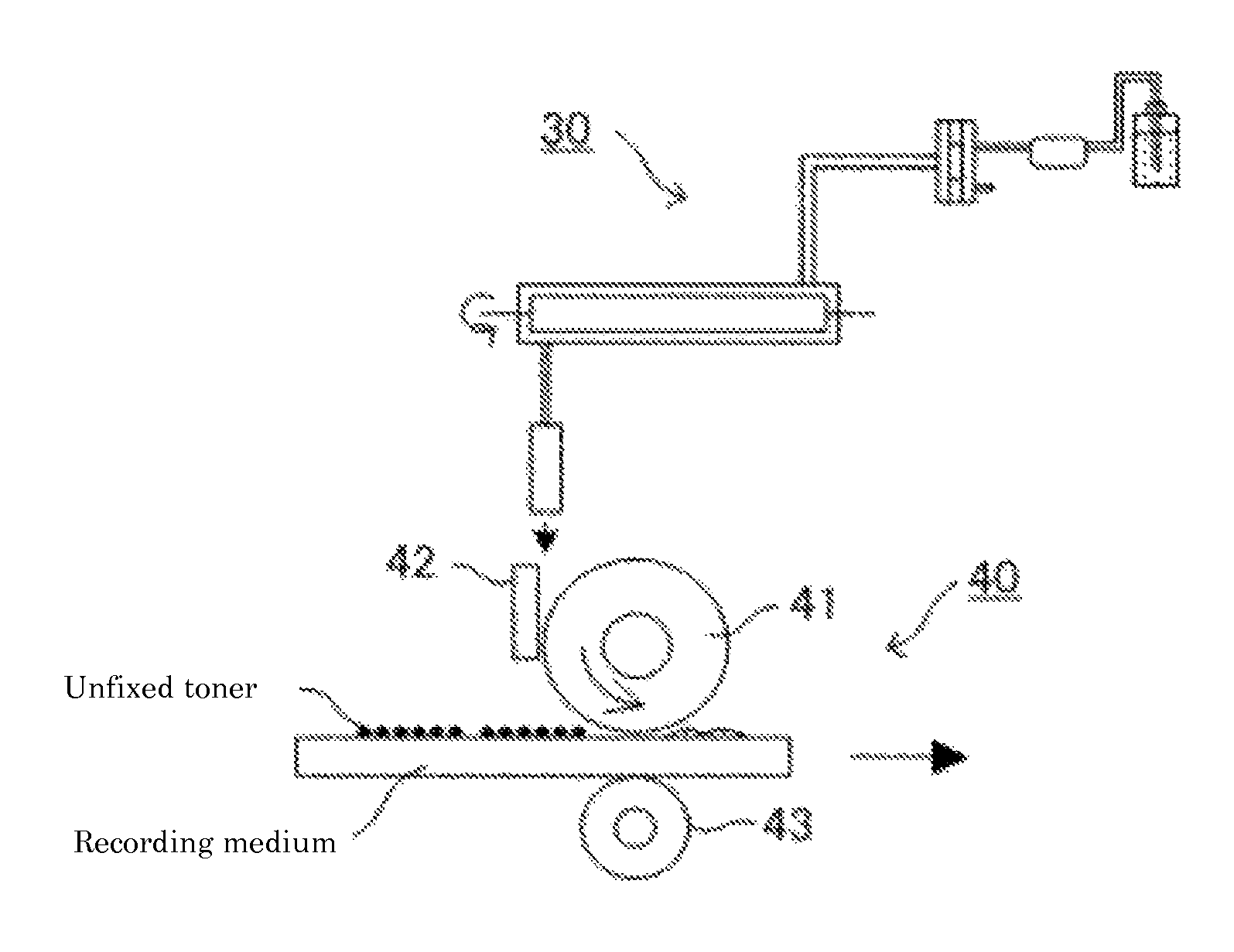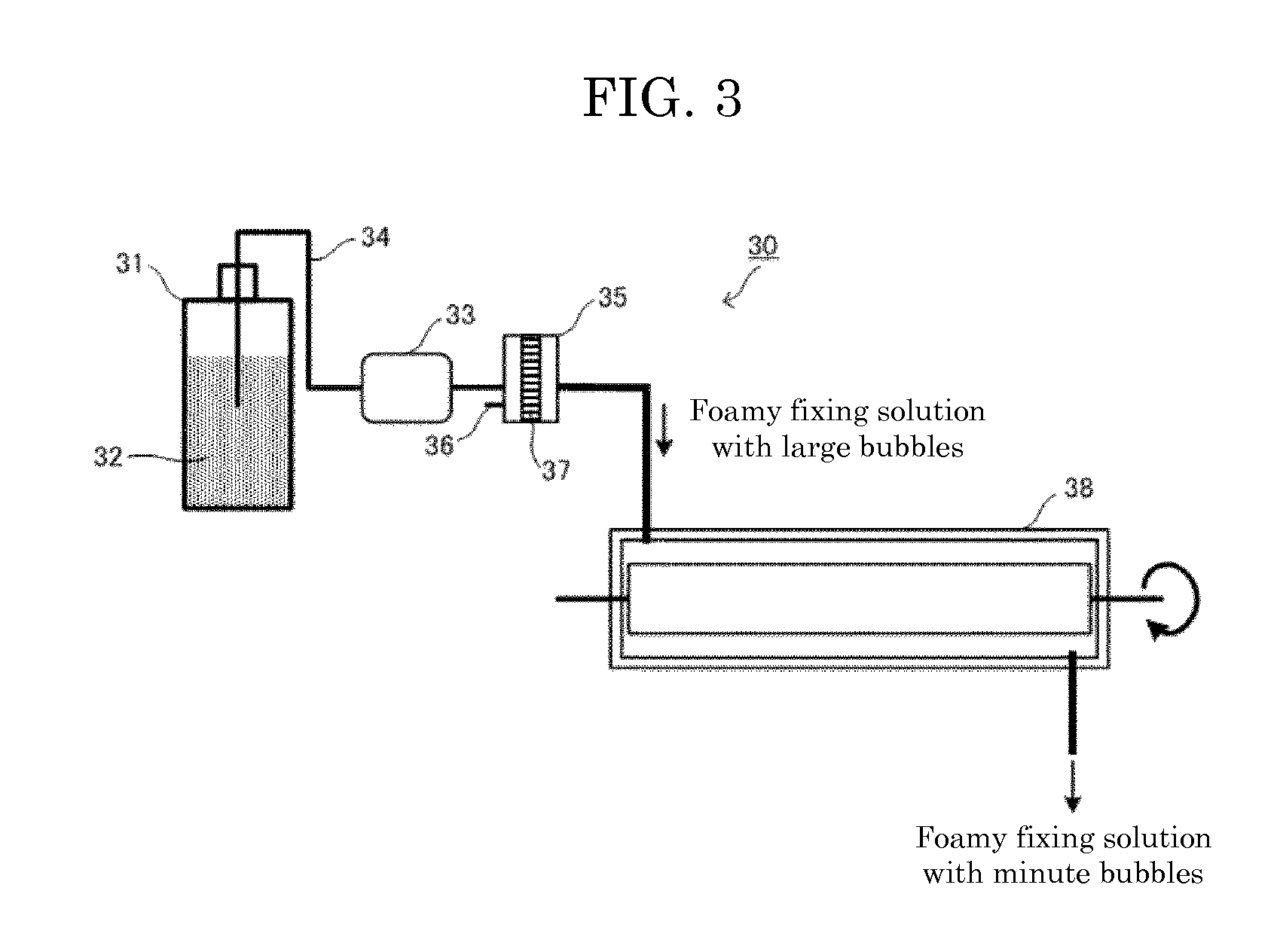Fixing solution, fixing method, fixing device, image forming method and image forming apparatus
a technology of fixing method and fixing device, which is applied in the direction instruments, developers, etc., can solve the problems of power consumption of electrophotographic image forming apparatus, and inability to solve offset and the remaining presence of tack in non-thermal fixing method, etc., to achieve superior color reproducibility and reduce tack
- Summary
- Abstract
- Description
- Claims
- Application Information
AI Technical Summary
Benefits of technology
Problems solved by technology
Method used
Image
Examples
example 1
Formulation of Fixing Solution
[0195]An agent which was solid at normal temperature and exhibited resin plasticizing capability when present in an aqueous solution, a wetting agent, a foaming agent, a foam booster and a penetrant were, in this order, added to the diluting liquid below with agitation, as each of these constituents dissolved in the diluting liquid, and a fixing solution 1 was thus prepared.
[0196]
Agent which was solid at normal temperature andexhibited resin plasticizing capability when presentin an aqueous solution (Solid plasticizer):Polyethylene glycol #1000 (HO—(C2H4O)n—H, n = 20, 20% by massweight average molecular weight: 950 to 1,050,manufactured by KANTO CHEMICAL CO., INC.)Foaming agentMyristic acid triethanolamine salt2.3% by massPalmitic acid triethanolamine salt1.1% by massStearic acid triethanolamine salt0.6% by massFoam boosterFatty acid alkanolamide (“MARPON MM”,0.5% by massmanufactured by Matsumoto Yushi-Seiyaku Co., Ltd)PenetrantPolyoxyethylene (POE) alk...
example 2
[0219]The same process as in Example 1 was carried out except that polyethylene glycol #2000 (HO—(C2H4O)—H, n=40, weight average molecular weight: 1,850 to 2,150, manufactured by KANTO CHEMICAL CO., INC.) was used instead of the polyethylene glycol #1000 and the amount of the ion-exchange water was changed from 70% by mass to 65% by mass. A fixing solution 2 was thus prepared.
[0220]This fixing solution was provided in the form of foam as in Example 1, using the device shown in FIG. 8 instead of the device shown in FIGS. 4A and 4B. After the provision of the fixing solution, the toner-attached paper was passed through a nip portion such that unfixed toner layers came into contact with a pressurizing roller that was a hollow rubber roller (rubber hardness: 20 degrees) housing an infrared heater and being positioned at a distance of 50 mm from the exit of a nip portion (where an applicator roller came into contact with the paper after the application of the fixing solution), with the s...
example 3
[0224]A fixing solution was prepared as in Example 1. This fixing solution is referred to as “fixing solution 3”.
[0225]Toner layers were formed on the PPC paper as in Example 1, using the polymerized toners and the pulverized toners.
[0226]Fixed images were obtained as in Example 1, using the fixing solution 3, the polymerized toners and the pulverized toners. In this Example, the amount of the foamy fixing solution provided was adjusted only to 200 mg.
[0227]The evaluations were carried out on these obtained fixed images as in Example 1. The results are shown in Table 3.
PUM
 Login to View More
Login to View More Abstract
Description
Claims
Application Information
 Login to View More
Login to View More - R&D
- Intellectual Property
- Life Sciences
- Materials
- Tech Scout
- Unparalleled Data Quality
- Higher Quality Content
- 60% Fewer Hallucinations
Browse by: Latest US Patents, China's latest patents, Technical Efficacy Thesaurus, Application Domain, Technology Topic, Popular Technical Reports.
© 2025 PatSnap. All rights reserved.Legal|Privacy policy|Modern Slavery Act Transparency Statement|Sitemap|About US| Contact US: help@patsnap.com



